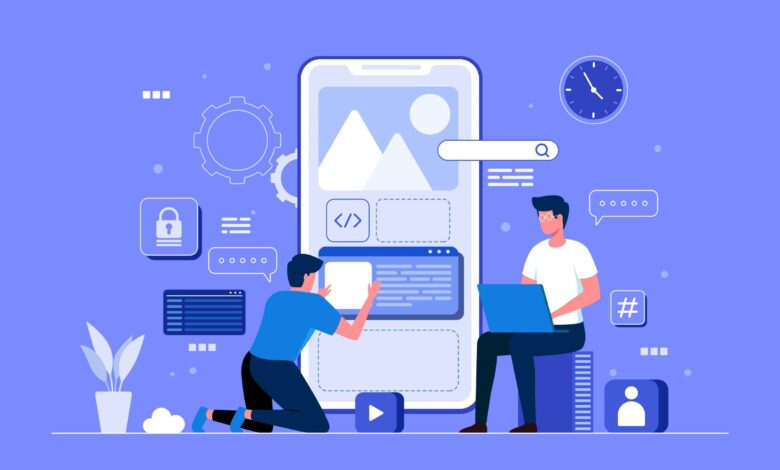App Development Without Coding in 2024

The demand for mobile applications continues to soar. Businesses, entrepreneurs, and individuals seek to create apps to engage with customers, streamline operations, and bring innovative ideas to life. However, not everyone possesses the technical skills required for traditional app development.
This is where no-code app development platforms come into play, revolutionizing the way apps are built. In this article, we will explore the landscape of app development without coding in 2024, highlighting its benefits, popular platforms, and key considerations.
The Rise of No-Code App Development
No-code app development platforms have democratized the app creation process, allowing anyone with an idea to build functional and visually appealing applications without writing a single line of code. These platforms offer intuitive drag-and-drop interfaces, pre-built templates, and a wide range of customization options, making app development accessible to non-technical users.
The rise of no-code app development can be attributed to several factors:
- Accessibility: No-code platforms eliminate the need for coding expertise, enabling individuals from diverse backgrounds to create apps.
- Speed: With pre-built components and templates, no-code development significantly reduces the time required to build and launch an app.
- Cost-Effectiveness: Traditional app development can be expensive due to the need for skilled developers. No-code platforms offer affordable alternatives.
- Flexibility: These platforms provide flexibility in terms of design and functionality, allowing users to iterate and make changes quickly.
- Empowerment: No-code development empowers entrepreneurs, small businesses, and non-profits to bring their ideas to life without relying on external developers.
Benefits of No-Code App Development
No-code app development offers a plethora of benefits, making it an attractive option for a wide range of users. Some of the key advantages include:
1. Accelerated Development
No-code platforms streamline the development process, allowing users to build apps in a fraction of the time it would take using traditional methods. This speed-to-market advantage is crucial in today’s competitive landscape, where being the first to launch can make a significant difference.
2. Cost Savings
Hiring skilled developers can be expensive, especially for small businesses and startups with limited budgets. No-code platforms provide a cost-effective solution, enabling users to create apps without incurring high development costs. Additionally, the reduced development time translates to lower overall project expenses.
3. User-Friendly Interface
The intuitive drag-and-drop interfaces of no-code platforms make app development accessible to non-technical users. Users can visually design their apps by selecting and arranging pre-built components, eliminating the need for coding knowledge. This user-friendly approach empowers individuals to take control of the development process.
4. Rapid Prototyping
No-code platforms facilitate rapid prototyping, allowing users to quickly create and test app concepts. This iterative approach enables users to gather feedback, make improvements, and refine their apps before launching them to the public. The ability to experiment and iterate fosters innovation and ensures that the final product meets user expectations.
5. Customization and Flexibility
Contrary to the misconception that no-code apps are limited in functionality, modern no-code platforms offer extensive customization options. Users can tailor their apps to meet specific requirements, add unique features, and integrate with third-party services. The flexibility of no-code development ensures that apps can evolve and scale as needed.
Popular No-Code App Development Platforms
As the popularity of no-code development continues to grow, several platforms have emerged as leaders in the space. These platforms offer a range of features and capabilities to suit different use cases and user needs. Let’s explore some of the most popular no-code app development platforms in 2024:
1. Appstylo
Appstylo is a versatile no-code app maker platform that empowers users to create fully functional mobile apps without writing any code. With its intuitive drag-and-drop interface and a wide selection of pre-built templates, Appstylo caters to various industries and use cases, from e-commerce to education and beyond. The platform also supports advanced customization options, enabling users to add unique features and branding elements to their apps.
2. Adalo
Adalo is another popular no-code platform known for its ease of use and robust feature set. It allows users to build both web and mobile apps using a visual interface. Adalo offers a wide range of pre-built components, such as forms, lists, and navigation elements, which can be easily customized to suit specific needs. The platform also supports integrations with external services, making it a powerful tool for creating dynamic and interactive apps.
3. Bubble
Bubble is a no-code platform that focuses on web application development. It provides a visual editor for designing user interfaces and a workflow editor for defining app logic. Bubble’s powerful backend capabilities allow users to create complex applications with databases, APIs, and user authentication. While Bubble has a steeper learning curve compared to some other no-code platforms, it offers unparalleled flexibility and scalability.
4. Glide
Glide is a unique no-code platform that specializes in turning Google Sheets into fully functional mobile apps. Users can create apps by simply designing a Google Sheet and then using Glide’s visual editor to customize the app’s appearance and functionality. Glide is ideal for creating data-driven apps, such as inventory management systems, event organizers, and employee directories.
5. Thunkable
Thunkable is a no-code platform that focuses on mobile app development. It provides a visual interface for designing app screens and a block-based editor for defining app logic. Thunkable’s extensive library of components and integrations allows users to create feature-rich apps with ease. The platform also supports live testing and deployment to both iOS and Android devices.
Key Considerations for No-Code App Development
While no-code app development offers numerous benefits, there are some important considerations to keep in mind to ensure a successful project:
1. Define Your Objectives
Before diving into app development, it’s crucial to clearly define your objectives and understand the problem you are trying to solve. Outline the key features and functionalities your app needs to have and prioritize them based on user needs and business goals.
2. Choose the Right Platform
Selecting the right no-code platform is essential to the success of your project. Consider factors such as ease of use, available features, customization options, and integration capabilities. Evaluate multiple platforms to find the one that best aligns with your requirements and skill level.
3. Plan Your App’s Structure
Even though no-code platforms simplify the development process, proper planning is still necessary. Create a detailed outline of your app’s structure, including the navigation flow, key screens, and user interactions. This will serve as a blueprint for the development process and help ensure a smooth and organized workflow.
4. Focus on User Experience
User experience (UX) is a critical aspect of any app. Ensure that your app’s design is intuitive, visually appealing, and easy to navigate. Pay attention to details such as button placement, font sizes, and color schemes to create a seamless and enjoyable experience for your users.
5. Test Thoroughly
Thorough testing is essential to identify and fix any issues before launching your app. Test your app on multiple devices and operating systems to ensure compatibility and performance. Gather feedback from users during the testing phase to make necessary improvements and enhancements.
6. Monitor and Update
Once your app is live, continuous monitoring and updates are necessary to keep it running smoothly and address any issues that arise. Use analytics tools to track user behavior and gather insights into how your app is being used. Regularly update your app to add new features, improve performance, and fix bugs.
The Future of No-Code App Development
As we look ahead to the future, no-code app development is poised to become even more powerful and versatile. Advancements in artificial intelligence (AI) and machine learning (ML) are expected to enhance no-code app creator platforms, enabling them to provide more intelligent and context-aware features. Additionally, the integration of voice recognition, augmented reality (AR), and virtual reality (VR) capabilities will open up new possibilities for no-code app development.
The continued growth of the no-code movement will also lead to the emergence of specialized platforms catering to specific industries and use cases. This will further expand the reach of no-code development, empowering more individuals and organizations to create innovative and impactful applications.
Conclusion
No-code app development has transformed the way apps are created, making it accessible to a broader audience and accelerating the development process. In 2024, the landscape of no-code development is rich with opportunities, offering a wide range of platforms and tools to suit diverse needs.
By using the benefits of no-code platforms and following best practices, anyone can turn their app ideas into reality without the need for coding skills. Whether you are an entrepreneur, a small business owner, or an individual with a vision, no-code app development opens up a world of possibilities for innovation and success.



